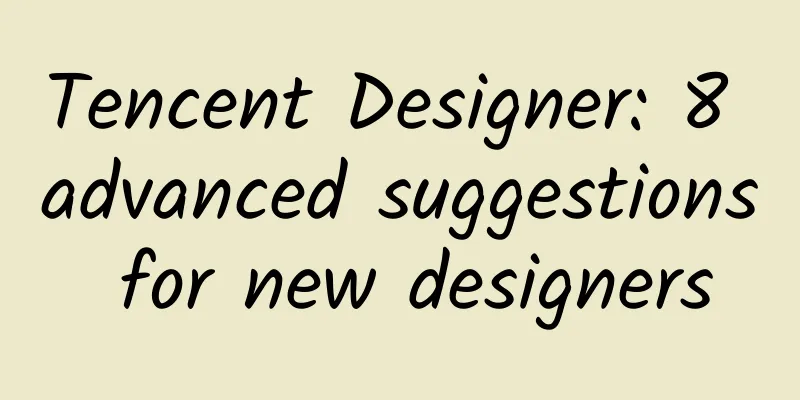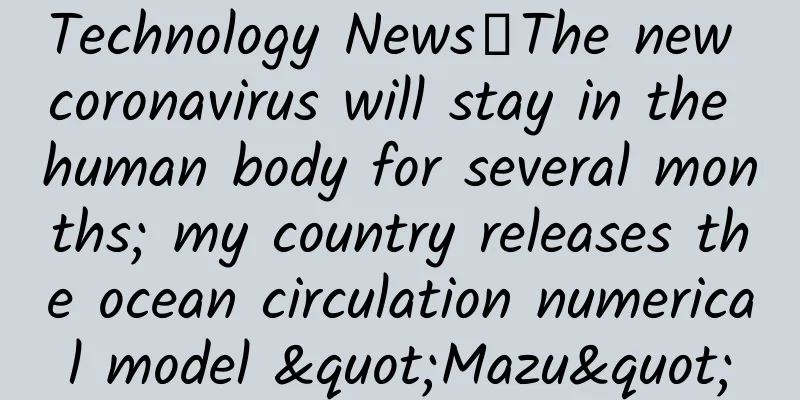Tencent Designer: 8 advanced suggestions for new designers

|
Recently, many young designers have come to chat with me. During the chat, it is not difficult to find that some students are anxious and confused about design. At the same time, they also hope that I can give them some suggestions on the design road. I have also given them some suggestions during private chats. I share them with you here, hoping to help some young friends clarify their direction. About Me In fact, I was very clear about my desire to pursue a career in design when I was a student, and I have been doing design work since graduation, so I feel very lucky to be able to combine my interest with my work. Although interest is the best mentor, it is more about persistence and passion. Only when you really love it will you spend time to study it and do it well. This passion is not a one-time thing, it requires continuous persistence. Even if the process may not be smooth, a firm goal can help you make continuous progress. Let me talk about myself in several stages Phase I - Student Years During that ignorant period of time, I didn’t think too much about many things. I just learned everything I saw that was good. Looking back now, I realized that I developed a lot of good habits during that time, such as self-study, organization and classification, teamwork, and so on. When I was a student, I had a lot of free time, so I liked to read tutorial books. I still remember that I learned Photoshop and CorelDRAW by reading books. When I started learning design, I spent every day on various design websites. Sometimes I would spend the whole day reading. After each reading, I would organize and collect other people's works, divide each type of work into folders, and check and study regularly. During this time, there happened to be a few classmates who loved design and learned and grew together. I would regularly complete some large and small projects with my classmates, each of us was responsible for different content, and we worked together to implement our works. Phase II - Graduation Due to the school and academic qualifications, I didn’t have a particularly good platform to work hard at, let alone a big company like BAT. In the 1.5 years after graduation, I was mainly engaged in graphic design, advertising design, and brand VI design. The company I worked for was a relatively small startup, but because the company was relatively small and there were not many people, I actually got a good training in all aspects, and the company was also willing to give some opportunities for newcomers to train and control some new projects. Phase III - Change of direction After working for more than a year, I felt the hot trend of Internet design, so I decisively sought a new career direction - UI design. After determining the new direction, I decided to use my spare time to self-study UI design, including: icon design, interface design, web design and other aspects (now looking back at some of the exercises at that time, they were a bit horrible, but this is also a process of precipitation). After 1-2 months of study, I found that it was difficult to improve my ability in this area through amateur practice, so I decided to resign from the previous company and find an Internet company to continue my design journey. After I joined the new company, I had a burst of improvement in my design ability. I was trained in many aspects. I was like a sponge, eager for new knowledge in all aspects. I had a great improvement. The leader at that time also affirmed my progress. Therefore, after about half a year, I got the opportunity to be the main project designer. Before this stage, I was responsible for designing 4 apps from zero to one. Stage IV - Qualitative Change This is a brand new career stage, and it is also the job I have been working for so far. Because of a friend's internal recommendation, I got an opportunity to work at Tencent, and I also seized this opportunity, which is a recognition of my efforts in the previous stage. When I first came to Tencent, I was also in a learning attitude, wanting to go to a big company to broaden my horizons and learn the real way of design. During the probation period, I quickly integrated into the team with my strong adaptability, and the team's acceptance of new students exceeded my initial imagination. During this period, I learned a lot of different thinking patterns, working methods and design processes, and my design has also made qualitative progress. The biggest feeling during the probation period is: under a big company and a big team, I always feel that there is a wonderful force pushing you forward, and it is a force beyond competition. The whole team learns and improves together. During the first 3-4 years at Tencent, I participated in many large and small projects, and my abilities in various aspects have also made qualitative progress. I have basically complemented my abilities as a visual designer in various aspects, such as graphics, interface, motion effects, demo design, etc. During this period, I also participated in the design of major projects as the main designer many times. However, when you do one thing for a long time, it is easy to form a solidified thinking mode, which is a fatal problem for designers. Therefore, at this time, I once again took the initiative to seek change, and strived for the opportunity of internal transfer, and came to a new team, where I also opened up a new horizon. This time, I was more clear about what I pursued, mainly two: first, to improve design thinking and precipitate my own systematic design thinking; second, to seek transformation, expand my horizons, and accept new challenges. With the help of the new leader and the training of the new project, I have been constantly summarizing and precipitating, and now I have basically formed my own systematic design thinking mode (I will share it later if I have the opportunity). In summary, these are the four stages I have gone through since I started designing (I can only briefly explain it through words, it is difficult to elaborate on it). In each stage, I will be very clear about my shortcomings, and make some choices and seek room for improvement in the next stage. It may be bland to express it in words, but the experience of the process is often the most profound only for the person involved. I have defined some keywords for the past period of time: self-study, breakthrough, change, progress, sedimentation, persistence in learning, and keeping the original intention. Some suggestions In fact, whether you are a young designer or a designer who has worked for several years, you will experience confusion at different times on the road of design exploration, but the points in each stage will be slightly different. And this confusion is mostly an external manifestation of our progress to the next stage, because there are too many options in our minds, which makes it impossible to decide, and it becomes entangled and difficult to balance. Here are some suggestions based on my own experience. 1. Establish your goals
The more confused you are, the more you need to clarify your goals, then discard all the interfering information and work hard towards your goals. My habit is to first set a big goal, then split it into multiple small goals. When the small goals are completed, the big goal is almost there. For example, when I switched from graphic design to UI design, my big goal was to become a UI designer. The basic knowledge a UI designer needs to have includes: graphic design, color design, interface design, motion design, demo design, etc. (and more). These basic knowledge naturally became my small learning goals. Only by thoroughly understanding these knowledge can I become a qualified UI designer. Therefore, after setting the goal, you also need to clearly understand the content or method to achieve this goal. 2. Learn to talk
Talking can help you solve temporary entanglements and open your heart. A few suggestions: Before communicating, first clarify your own shortcomings, and try to think about and find some solutions, and then find some friends to talk to, so that others will give you more targeted advice; find someone who is better than you to talk to, you can talk to your superiors, superiors or some designers who are better than you, because they often see things more comprehensively than you do and can better help you overcome the difficulties of the period. When I encounter this kind of confusion, I will take the initiative to communicate with the leader or director face to face and seek some advice. Basically, such communication is effective every time. There are two benefits of seeking communication with superiors:
3. Trust the team
I believe that team strength is greater than individual strength. There must be people with various abilities in a team. Therefore, we can keep a normal mind and learn from the strengths of each partner. More communication and learning will make it possible for us to make greater progress and promote team cooperation. In this regard, I would like to share two common behaviors in daily work:
4. Dare to change
When you find that your current state is a bit too comfortable or uncomfortable, you should dare to jump out of the existing framework and try some changes. In general, when we have not made progress in a company for a long time, we might as well consider changing to a better company to continue working hard. Through such changes, we can get a practical buffer and think about our future direction. In small terms, for example, in terms of design style, if most of the projects in our work are more tough, then we can try some soft designs in our spare time, or try more different styles of solutions in actual work to find the balance point and break the previous cognition of existing things. 5. More sedimentation
It is recommended to do more summaries in daily projects to help yourself review the process in the project, precipitate the applied knowledge points and design techniques, etc. In addition to the summary of the project, you can also do some professional knowledge sorting to establish your overall knowledge structure. For me, I should be a negative example in this regard. In the first three or four years of my work, I hardly did any actual project summaries, which led to a period of scattered knowledge structure. In the past two years, I have paid more and more attention to this aspect. Every time I have summarized and settled, I feel that a project has ended. Sometimes we may feel that we don’t have time to summarize this aspect, or feel that this is not a big design and there is no need to summarize it, but in fact, the complete design thinking is pieced together from the summary of these small points. Here I share some of my little habits in this regard. Develop the habit of fragmented records You can use various tools (QQ documents, Youdao Notes, mobile notes, etc.) to record what we think about in our daily life. You will find that as you accumulate day by day, this article has basically taken shape. I personally prefer to use the WeChat applet version of QQ documents for my notes, so I can record at any time while watching WeChat.
Take control of the overall situation and make an outline first When writing a summary or a sedimentation article, first record the general outline in points, and then break down the big points into small points for extension. This way, most of the copywriting can be completed quickly. The structure I usually use is roughly as shown below. Grasp the small points, elaborate in depth, and be comprehensive and systematic In the actual design process, there are many very detailed design considerations. We should seize these small points and move on to deeper design thinking, or whether we have comprehensive considerations of various design options when designing the content itself.
Express your own opinion When writing some articles about design knowledge points, the most fearful thing is to repeat what others say, and the completed article may seem familiar to others. Therefore, before writing, you should think about your understanding of this aspect of design, and you can draw 2-3 lines for yourself before making a decision.
6. Cultivate aesthetics
As a designer, it is very important to cultivate one's own aesthetic sense. If one's aesthetic sense is not good, no matter how meticulous one's work is, it will be lacking. In terms of design, we can get a good improvement through some design websites. In addition, some cross-border aesthetic cultivation is equally important, such as film art, clothing, fashion brands, home furnishings, games and other aspects. We can pay attention to all aspects of content. 7. Think in multiple ways
When designing, it is recommended to design with multiple schemes instead of discussing with one design scheme. In addition to helping you expand your design thinking, multi-scheme design can also improve the efficiency of design draft confirmation. Here I share several common methods I use when designing with multiple schemes in daily life. Multiple concept representation Based on a content, try to express it by putting different concepts into different solutions. The overall concept needs to be closely related to the worldview or main design direction of the original product. This method is very suitable for determining the general direction in the early stage of design, which can help improve the efficiency of determining the direction. Exhaustive method Try as many possible solutions as possible, and finally vote to determine the best solution. This is a more diffuse thinking method, often used in icon or logo design. Even in the polishing of some detailed solutions, we can use the exhaustive method to achieve the purpose of trying multiple solutions. Style Differences Style differences can include many ways, such as: differences in board structure, graphic style, texture, etc. to create multiple design options. Style differences can be roughly divided into large differences and small differences. The following two examples will briefly explain. There will be an article about multi-scheme design later, but here I will briefly talk about a few key points. 8. Develop hobbies
Designers should not only focus on design itself, but also have fun in life. Cultivate a hobby to make your spare time more different and find satisfaction in life outside of hobbies. Designers around me have many different hobbies, such as skateboarding, custom leather goods, American Barber, fashion design, dance, console games, music, sneaker collection, model collection, etc. Of course, you can also divide this interest into long-term and short-term. For example, my long-term interest has always been to collect some Dragon Ball figures. Although there are not many, I still feel very satisfied every time I collect a new one. A short-term interest is to grow dreadlocks. In the past two years, I would braid a dreadlock every August, and leave it for about six to eight months before shaving it off. My latest interest is to learn barbering, helping some familiar colleagues cut their hair, and cutting my own hair. This saves me a lot of money. In the past, going to a barbershop would cost at least 200 yuan, but now I can shave it anytime if I don’t like it. Final Thoughts Half of 2020 has passed. Are you satisfied with your progress in the past six months? There are several main purposes for writing this article:
|
<<: Amap launches new feature nationwide: Navigation voice prompts waterlogging points
>>: What changes will 5G mobile phones bring under the new 5G standard R16?
Recommend
Seven Paint: Domestic & TIKTOK short video live broadcast training camp, the global live broadcast sales trend is coming, hurry up and make money
Seven Paint: Domestic & TIKTOK short video li...
In 2025, ZeroBeam Full Stack 3.0 will be fully implemented to support L3 autonomous driving
(May 24, 2024, Shanghai) At the "SAIC New En...
9 Tips for Facebook Ads Creatives!
Have you ever experienced your Facebook ad perfor...
Case studies of Mayu maternal and child care and parent-child education industry
In order to know what kind of industry advertisem...
The superstition of big data in the post-House of Cards era has been dispelled. The helmsman behind the ratings myth is still the screenwriter
When talking about big data in film and televisio...
I am a flasher, not an experienced driver!
I'm a brush machine dealer. Compared with the...
Why was the paper of this Zhejiang female scientist cited by an academician of the French Academy of Sciences? New targets and new strategies will illuminate the future of childhood tumors
Reporter Weng Danni Photographer Jin Jingxin Publ...
Don’t know how to increase your conversion rate? Let’s play games!
There is a very interesting thing recently. There...
A case study for setting up advertising accounts in the education industry!
In the first half of the year, various segments o...
Dapeng Education - Practical Course in Photo Studio Design Industry Photography Post-production
Dapeng Education - Studio Design Industry Practic...
Comparison of the advantages and disadvantages of DDD CQRS architecture and traditional architecture
In recent years, in the field of DDD, we often se...
【Zeng Dapeng】Dapeng's complete trading system
[Zeng Dapeng] Introduction to Dapeng's complet...
The Civic TYPE R special edition concept car may enter the Chinese market in the future
During the 2018 Tokyo Tuning Show, Honda official...







![Practical Photoshop for Beginners to Masters in 2020 [High-definition quality with materials]](/upload/images/67cc0b9188b76.webp)

